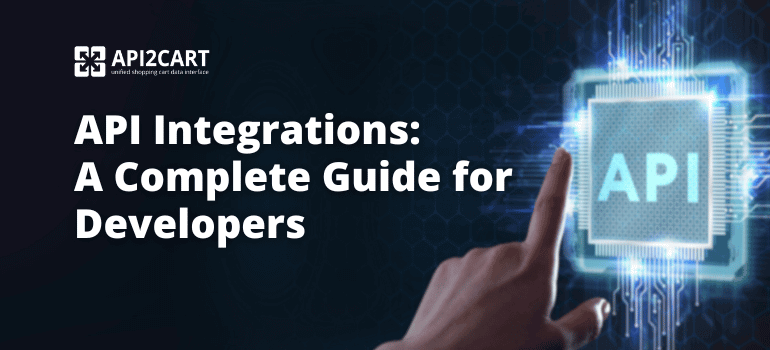
eCommerce software and applications providers and developers that want to achieve success on the market need to become aware of the importance of setting up reliable connections with the APIs of eCommerce platforms.
Nowadays, it is highly important to know what APIs are, their pitfalls and how exactly they work. Especially if you provide software or app for e-merchants.
APIs are the key in digital worlds that allow various systems to communicate with others. Without them, your solution won't be able to interact with other third-party software and programs. And if you operate on the eCommerce market, then the connection with the eCommerce platforms APIs is definitely a must-have for you.
In this article, we’ll dive deeper into the benefits of getting your API connection with the most common shopping platforms out there. We’ll also teach you some basics about how an API works and reveal to you the four most common ways to work with the data used by your clients using eCommerce platforms.
In the end, we’ll get practical and show you how to quickly develop a winning integration with the APIs of the leading eCommerce platforms
What is an API?
If you’ve been active in the eCommerce industry for some time, you’re probably quite used to the term API, which is thrown around quite a lot. An API (or Application Programming Interface) acts as an intermediary between two digital products. Simply put, the API is like the middle man between two apps trying to communicate with each other.
Software that needs to access information or functionality from some other software calls the API of that other program, passing along the requirements of what data or functionality it needs. The other program returns the data or functionality requested by the original application.
The API specifies the interface by which the two software or applications communicate. The API documentation includes information on function calls.
Each API consists of function calls—language statements that request the software to perform particular actions or services.
As an eCommerce software and application provider or developer, you can best understand what an API is by thinking of the actual process of gaining access to your customers’ data. Basically, to offer your services to e-shop owners, you need to be able to work with information about their site visitors and on-site products. To gain access to that info, you can use an API.
Once your server requests the specific information, the shopping cart’s server sends you back the information in a JSON format.
The APIs can usually come in two types:
- SOAP (Simple Object Access Protocol): this standard protocol uses the XML format to define the message structure along with the method of communication.
- REST (Representational State Transfer): this is a unique set of architectural principles that use specific characteristics to transfer information smoothly.
What is eCommerce API?
Each eCommerce platform or marketplace has its own API. For example, Amazon API allows exchanging data programmatically on orders, payments, listings, or reports. The other example is Magento API which allows providing calls for working with resources such as categories, customers, or sales orders.
The entire API infrastructure revolves around requests and responses. Usually, sending a request involves one of the following methods: PUT, GET, POST, or DELETE. The response to the request is sent back to you either in XML or JSON format.
Each request method has its specificities. For example, you can use PUT to change the state of a resource or update it. You can also use GET to retrieve a resource, while POST enables you to create a new resource. Obviously, DELETE method is possible to use to remove a resource or a product.
If you’re working with your clients’ shipping orders, you can use PUT to update delivery status, from pending to sent. You can also use GET to retrieve a list of items that have shipped, and you can use DELETE to remove an item that has been sent from a customer’s basket.
These four methods allow you to “play” with data related to products, orders, warehouse stocks, shipping info, or even with taxes or customer’s sensitive information.
Top 10 The Best APIs of eCommerce Platforms
Each API of eCommerce platform has its specifics. So let’s take a closer look at some of the APIs out there that can be significant for your business.
eBay API
eBay API offers access to all core capabilities that are usually used together with selling, buying, or searching actions. eBay's latest APIs use modern API standards, including OAuth 2.0 for authentication, JSON payloads, and RESTful design principles.
Magento API
Magento API enables software developers to manage Magento e-stores seamlessly. Such data includes categories, products, customers, and sales orders. Magento supports the API types like REST and SOAP. Magento REST API provides functions that can be used to perform requests and receive responses using the HTTP protocol. For example, GET, POST, PUT, or DELETE methods allow you to manage Magento data as you need.
WooCommerce API
WooCommerce API makes it possible for developers to read, create, update, and delete WooCommerce data. It includes the data on products, prices, orders, customers, and shipping statuses. You can use WooCommerce REST API to read, create, update, and delete data in a WooCommerce database.
Shopify API
Shopify API enables eCommerce software providers to access store data from Shopify and use it for their purposes. The API supports such formats as XML and JSON. It can be used with HTTP requests such as GET, POST, PUT, and DELETE.
BigCommerce API
BigCommerce API is used by over 150k merchants worldwide and allows developers to retrieve a store’s catalog while also creating new products, setting up automation, and troubleshooting common problems.
Squarespace APIs
APIs of this eCommerce platform include Inventory API, Orders API, Products API, Profiles API, Transactions API and Webhook Subscriptions API. Their usage enables developers to access stock info, get order history, manage products, access financial data for orders, etc.
Ecwid API
Ecwid API uses OAuth 2.0 for authentication. Using it, software developers can access store data and perform actions on behalf of store owners. eCommerce app developers can retrieve and manage data related to an Ecwid store. That includes product info, customer data, orders, and categories. Ecwid supports webhooks, which are HTTP callbacks that allow any app to be notified of events in an online store, such as when a new order is created.
Etsy API
It enables connection of different software solutions and apps with the Etsy eCommerce marketplace. Also, the API of Etsy permits access to Etsy product listings and enables the management of online shop info. Etsy API provides access to the Etsy store data related to products, stores, orders, and reviews. The apps must be authenticated with Etsy using OAuth 2.0. It ensures secure access to Etsy's data for Etsy sellers and buyers.
Wix API
Wix API is a type of REST API. It means that it uses standard HTTP methods (for example, GET, PUT, POST, DELETE) for communication and adheres to REST principles for data management. Wix API grants access to a wide range of data related to Wix e-stores. For instance, the data like site settings, content, site members, and page data. Wix platform offers developer documentation, tutorials, forums, and a developer community to assist developers in building apps using the Wix API.
MercadoLibre API
MercadoLibre platform offers the API that enables devs to integrate with and extend their software functionality of the MercadoLibre platform. The MercadoLibre API is a RESTful API that uses HTTP methods like, for instance, GET, POST, PUT, and DELETE.
How to Develop the Integration with eCommerce Platform API in 2023?
There is no doubt that with so many unique APIs out there, developing strong and reliable connections with each shopping platform takes time and requires a vast amount of financial investment. The easiest way to connect with an eCommerce platform API is by using a specific service such as API2Cart.
Using this service, you can avoid all the hassles and integrations that come from setting up a manual integration with each eCommerce platform. Instead, you can connect your eCommerce software or app to 40+ shopping platforms at once via API2Cart unified API. The platforms available for connection include WooCommerce, Amazon, Salesforce Commerce Cloud, Ecwid, Magento, Shopify, Squarespace, eBay, etc.
Our service works perfectly for any eCommerce software in niches such as warehouse, order and inventory management, ERP, marketing automation, dropshipping, mobile commerce app development, or repricing and price optimization. Once connected to API2Cart, you can start experimenting with the capabilities we provide, build up new features for your software, and take it to a whole new level.
API2Cart provides more than 100 API methods. With their help, you can easily get, update and delete eCommerce platforms' data. The data include products, prices, orders, shipping info, and e-store customers' details. API2Cart API Docs contain the info on each API method with their request and response examples.
To test API2Cart functionality, you need to create your free account on this service.
The development of the integration with eCommerce platforms via API2Cart allows your company to reduce TCO, minimize time & financial investment, and reduce time spent on integration maintenance. Best of all, you can try our API2Cart for free over 30 days and see exactly how it works.
Contact us now to learn more about using an API eCommerce platform integration for your business’ growth.



